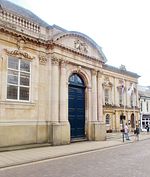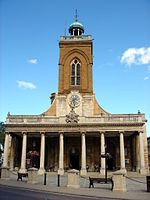Northampton St. John's Street railway station

Northampton St. John's Street was a railway station and the northern terminus of the Midland Railway's former Bedford to Northampton Line which served the English county town of Northampton from 1872 to 1939. Its closure came about as a cost-cutting measure implemented by the London, Midland and Scottish Railway which diverted services to the nearby Northampton Castle station. After closure the elegant station building was used as offices and the line for the storage of rolling stock; the site was cleared in 1960 to make way for a car park. The car park has now been built on and is the location of St Johns Halls of Residence for The University of Northampton.
Excerpt from the Wikipedia article Northampton St. John's Street railway station (License: CC BY-SA 3.0, Authors, Images).Northampton St. John's Street railway station
Saint John's Street,
Geographical coordinates (GPS) Address External links Nearby Places Show on map
Geographical coordinates (GPS)
| Latitude | Longitude |
|---|---|
| N 52.2349 ° | E -0.8955 ° |
Address
Northampton St. John's Street
Saint John's Street
NN1 1ER , St James' End
England, United Kingdom
Open on Google Maps











